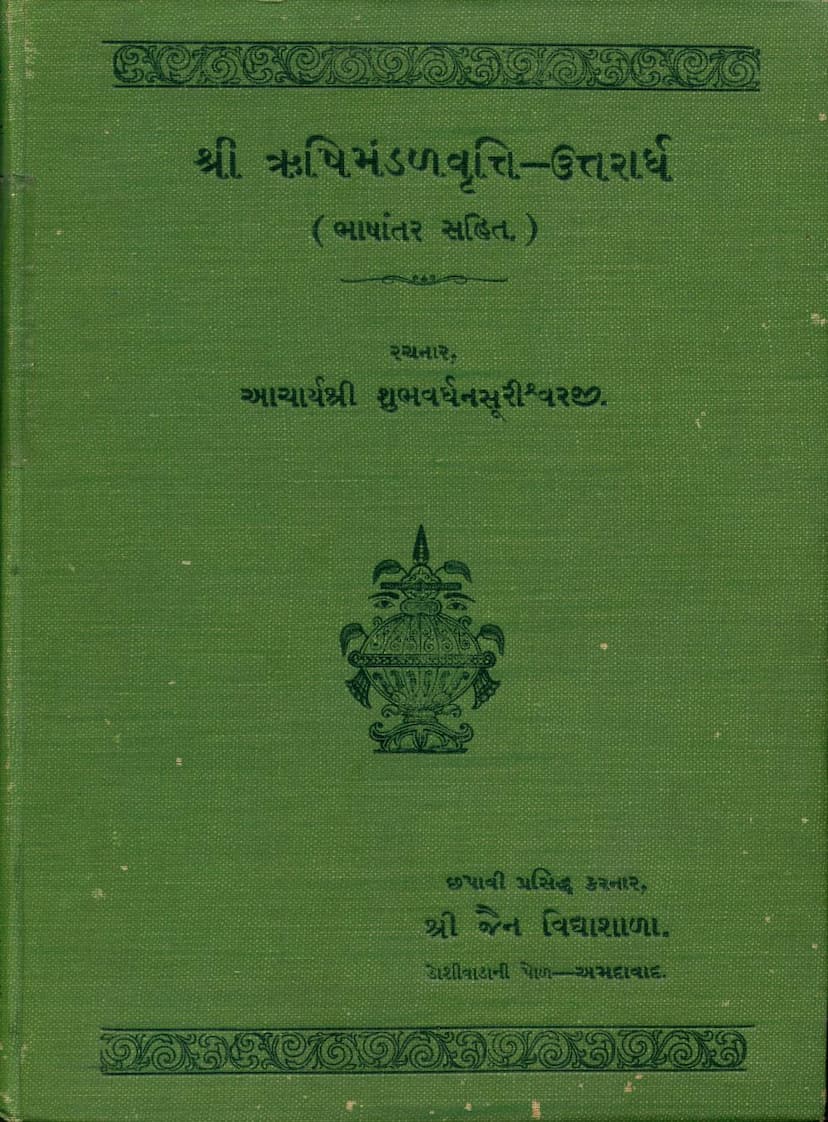Rushimandal Vrutti Uttararddh
Added to library: September 2, 2025

Summary
Based on the provided Gujarati text, here's a comprehensive summary of the "Rushimandal Vrutti Uttararddh" in English:
Book Title: Rushimandal Vrutti Uttararddh (The Second Part of the Commentary on Rushimandal) Author(s): Acharya Shubhavardhansurishwarji (Original Composition), Shastri Harishankar Kalidas (Translation) Publisher: Shri Jain Vidyashala, Ahmedabad Catalog Link: https://jainqq.org/explore/022020/1
Overall Purpose and Context:
This volume, "Rushimandal Vrutti Uttararddh," is the second part of a commentary that follows the "Purvardh" (first part). The Jain Vidyashala in Ahmedabad published it after a significant demand for the second part. The preface expresses the hope that this book will help readers progress on their spiritual path and understand the lives of past great souls. The text emphasizes the richness and resilience of Jain literature, which has overcome various challenges like destruction, theft, and decay.
Key Themes and Content:
-
Categorization of Jain Literature: The text highlights the traditional categorization of Jain literature into four "Anuyogas" (traditions or approaches): Dravyanuyoga (dealing with substances), Ganitanuyoga (mathematics and cosmology), CharanKarananuyoga (rules of conduct), and Kathanuyoga (narratives and stories). "Rushimandal Vrutti" is identified as a work belonging to the Kathanuyoga.
-
Importance of Kathanuyoga: The preface stresses the value of Kathanuyoga, especially in the current times. It states that reading captivating stories and historical accounts, especially those found in Jain literature, can uplift the mind and guide youth away from negative influences. Reading is described as essential "food" for the mind, and Jain narratives are considered pure and beneficial, serving as a means to impart religious teachings and strengthen faith.
-
Content of Uttararddh:
- The "Uttararddh" section contains approximately 70 stories and biographies of revered figures.
- It begins with the story of Keshigacharyaka Gadhara, who debated with King Pradeshi and converted him to Jainism. This narrative is detailed, covering the king's skeptical arguments against the existence of a soul and Keshigacharyaka's logical refutations. It also describes the discussion between Keshigacharyaka and Gautama Swami (a chief disciple of Lord Mahavir) regarding differences in the vows prescribed by different Tirthankaras (Parshvanath and Mahavir), and the significance of external appearance versus inner determination.
- The book includes biographies of numerous other prominent figures, including:
- Shripundarik-Kundarik
- Lord Mahavir's parents (Devananda and Rishabhadatta) and their past lives.
- Karkandu Muni
- Jayavarma (Dwimukha)
- Namiraja
- Nagati
- Shivraj
- Prasannachandra Rajarshi
- Various other monks and sages like Kshullaka, Lah, Supratishtha, Suvrat, Varadatta, Drdaprahari, Kurugadu, Kadina, Dina, and Sevada.
- Stories also feature kings like Dashanabhadra, Metanama, Illachiputra, Chilatiputra, Mrigaputra, Indranaga, Dharmaruchi, Tetali, Jitashatru, Ardrakumar, Udayan, Sudarshan, Gangeya, Jinpalita, Kapila, and others.
- The latter part of the book covers the lives of figures like Shri Harikesh, the six great sages starting with Sanyata, Anathi, Samudrapala, Jayagosha, Vijayaghosh, Annikputra, Hinna, Kaushikyarya, Devilasuta, Kurmaputra, Chandarudra, Dhanyakumar, Shitalacharya, Subahukumar, Rodaka, Kandaka, Tishya, Kurudatta, Abhayakumar, Udya, Sudarshan, Gangeya, Jinpalita, Dharmaruchi, Jinvadeva, Kapila, and others.
- It concludes with the stories of Shri Jambu Swami (the last Kevali), Shri Bhadrabahu Swami (Shrutakevali), Shri Sthalibhadra Swami (the final Shrutakevali), and Shri Kapila Muni.
-
Emphasis on Virtues and Spiritual Growth: Throughout the narratives, the text emphasizes virtues such as faith, perseverance, renunciation, righteousness, knowledge, conduct, and spiritual detachment. The stories illustrate how these virtues, often tested through hardships, austerAas, and temptations, lead to liberation (Moksha).
-
Relevance to Modern Times: The preface explicitly mentions the book's potential benefit for the youth of today, aiming to steer them towards spiritual guidance and away from detrimental influences.
Author and Translator:
- Acharya Shubhavardhansurishwarji: The original composer, likely a respected Jain scholar or ascetic who compiled these narratives.
- Shastri Harishankar Kalidas: The translator, who made this valuable text accessible through translation into Gujarati (implied by the original text and publisher being Gujarati).
Publisher and Publication Details:
- Shri Jain Vidyashala, located in Doshivada Ni Pol, Ahmedabad.
- The publication dates are mentioned as Veer Samvat 2452 (corresponding to 1958 CE), with the first edition priced at Rs. 2-8-0.
Overall Significance:
"Rushimandal Vrutti Uttararddh" serves as a repository of exemplary lives and significant events from Jain history. It aims to provide moral and spiritual guidance through captivating narratives, reinforcing the principles of Jainism and encouraging readers towards a virtuous and enlightened life. The inclusion of numerous biographies underscores the Jain emphasis on learning from the lives of past ascetics and spiritual leaders.